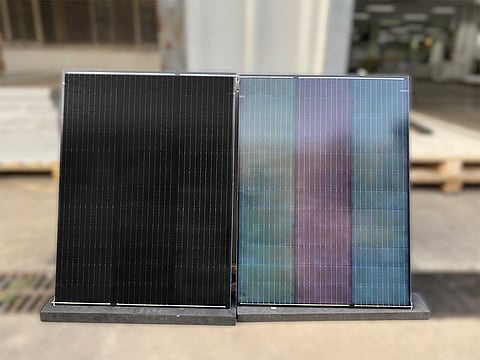

Could adding a dash of colour make solar technology more attractive? Conventional solar panels can look underwhelming as more public spaces incorporate photovoltaic (PV) technology. A new type of panel that takes on colourful hues and is almost as efficient as traditional ones might be a solution.
Photovoltaic panels are typically a deep black colour because their job is to absorb light. Colours are the result of some frequencies of light getting reflected.
Most attempts to give PV devices colour decrease their ability to absorb light and generate power, a report by scientists at American Chemical Society (ACS) Nano said. ACS is a non-profit chartered by the United States’ Congress.
Their findings were reported in High-Efficiency, Mass-Producible, and Colored Solar Photovoltaics Enabled by Self-Assembled Photonic Glass, which was recently published in ACS Publications.
Building-integrated photovoltaics is crucial for developing zero-energy buildings and sustainable cities. But great efforts are needed to make PV aesthetically pleasing, the report explained.
A structural material that would be easy and inexpensive to apply was the goal of the scientists Tao Ma, Ruzhu Wang and colleagues.
Low impact on efficiency of power conversion and mass-production at a low cost were some goals of the researchers while looking into technology to colour PVs.
Structural sources of color were created by the researchers that take advantage of microscopic shapes. As a result, only a very narrow and selective portion of light, like the scales on butterfly wings, get reflected.
A thin layer of photonic glass material was sprayed onto solar cells' surfaces. The glass was made of a thin, disorderly layer of zinc sulphide spheres that were dielectric and microscopic.
Although most light could pass through the photonic glass, selective colours were reflected due to the spheres. The solar panels took on blue, green and purple hues as a result, which did not hamper power generation much.
The power generation efficiency dropped from 22.6 per cent to only 21.5 per cent. Solar panels manufactured with the photonic glass layer also maintained their colour and performance during standard durability tests. The fabrication could be scaled up, too, the researchers found.
The long-term stability of the panels was also put to the test with a 10-day outdoor exposure and a damp-heat test. The results confirmed photonic glass was a promising strategy for coloured PVs that have high efficiency and are practical.
The researchers plan to explore ways to make the colours more saturated and achieve a broader range of colours.